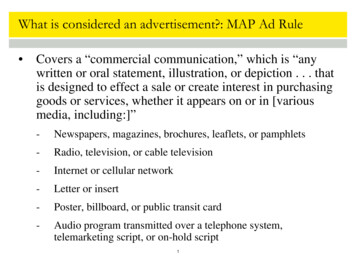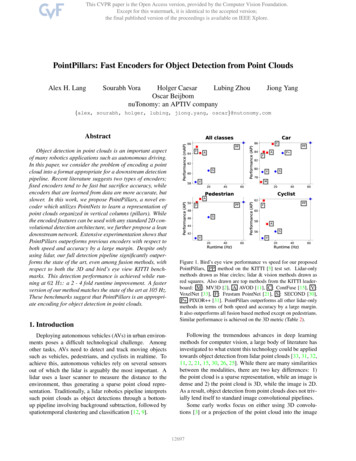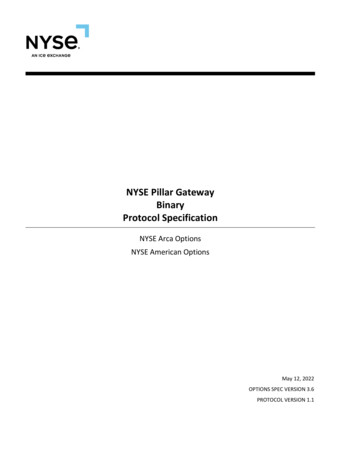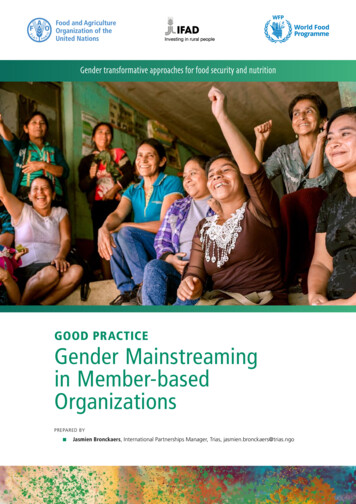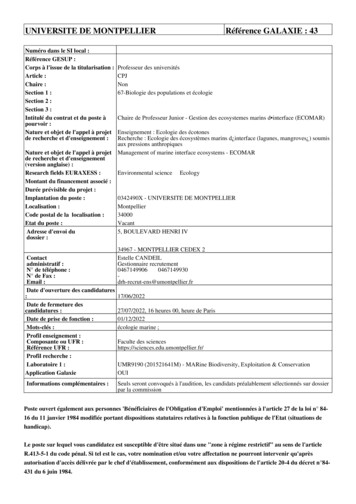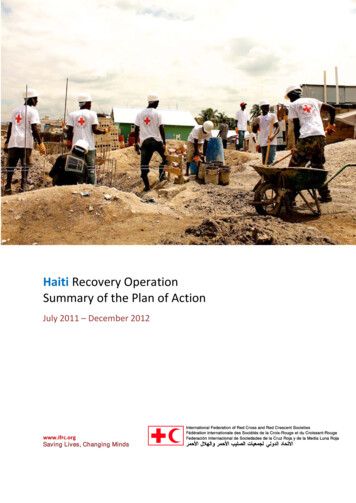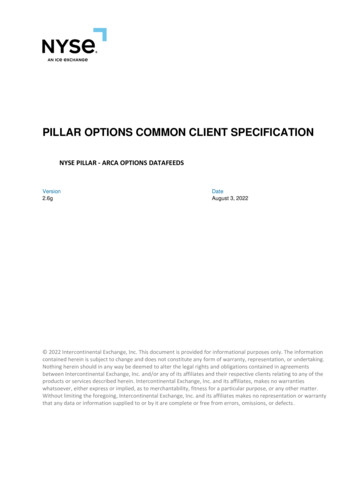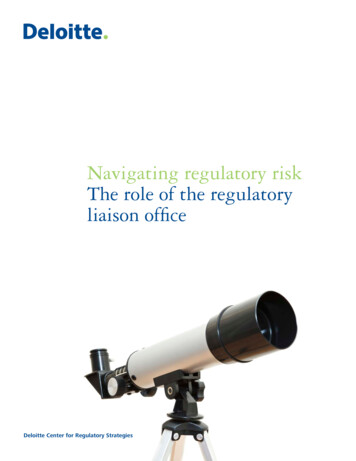
Transcription
Pillar 3 Regulatory DisclosuresFor the quarterly period ended September 30, 2021
CITIZENS FINANCIAL GROUP, INC.September 30, 2021 Pillar 3 Regulatory DisclosuresTABLE OF CONTENTSGlossary of Acronyms and Terms.2Introduction.4Report Overview.4Scope of Application.5Risk Governance.5Capital Structure and Adequacy. .6Capital Structure.6Capital Adequacy Process. 8Stress Capital Buffer . 10Credit Risk. 11Credit Risk Exposure. 11Counterparty Credit Risk-Related Disclosures. . 15Credit Risk Mitigation. 16Securitization. 16Equities (Non-Trading). 18Market Risk. 19Appendix 1 - Citizens Financial Group, Inc. Pillar 3 Regulatory Disclosures Matrix . 20Appendix 2 - Forward-Looking Statements. 231
CITIZENS FINANCIAL GROUP, INC.September 30, 2021 Pillar 3 Regulatory DisclosuresGLOSSARY OF ACRONYMS AND TERMSThe following is a list of common acronyms and terms we regularly use in our financial reporting:AACLAdjusted Allowance for Credit LossesACLAllowance for Credit Losses: Allowance for Loan and Lease Losses plus Allowancefor Unfunded Lending CommitmentsAFSAvailable for SaleAOCIAccumulated Other Comprehensive Income (Loss)BHCBank Holding CompanyBoard or Board of DirectorsThe Board of Directors of Citizens Financial Group, Inc.CBNACitizens Bank, National AssociationCCARComprehensive Capital Analysis and ReviewCECLCurrent Expected Credit Losses (ASU 2016-13, Financial Instruments-CreditLosses (Topic 326): Measurement of Credit Losses on Financial Instruments)CET1Common Equity Tier 1CET1 capital ratioCommon Equity Tier 1 capital divided by total risk-weighted assets as definedunder the U.S. Basel III Standardized approachCitizens, CFG, the Company, we,us, or ourCOVID-19 pandemicCitizens Financial Group, Inc. and its SubsidiariesCRACommunity Reinvestment ActCSACredit Support AnnexCVACredit Valuation AdjustmentDodd-Frank ActThe Dodd-Frank Wall Street Reform and Consumer Protection Act of 2010FDIAFederal Deposit Insurance ActFHLBFederal Home Loan BankFHAFederal Housing AdministrationFHLMCFederal Home Loan Mortgage CorporationFNMAFederal National Mortgage AssociationForm 10-KAnnual Report on Form 10-KForm 10-QQuarterly Report on Form 10-QFR Y-9CRegulatory Financial Statements for Bank Holding CompaniesFRB or Federal ReserveGAAPBoard of Governors of the Federal Reserve System and, as applicable, FederalReserve Bank(s)Accounting Principles Generally Accepted in the United States of AmericaGNMAGovernment National Mortgage AssociationHSBCHSBC Bank U.S.A., N.A.HSBC branchesHSBC’s East Coast branches and National Online deposit businessInvestorsInvestors Bancorp, Inc.MBSMortgage-Backed SecuritiesMid-AtlanticDistrict of Columbia, Delaware, Maryland, New Jersey, New York, Pennsylvania,Virginia, and West VirginiaMidwestIllinois, Indiana, Michigan, and OhioModified AACL TransitionThe Day-1 CECL adoption entry booked to ACL plus 25% of subsequent CECL ACLreserve buildModified CECL TransitionThe Day-1 CECL adoption entry booked to retained earnings plus 25% ofsubsequent CECL ACL reserve buildMSRsMortgage Servicing RightsConnecticut, Maine, Massachusetts, New Hampshire, Rhode Island, and VermontNew EnglandCoronavirus Disease 2019 Pandemic2
CITIZENS FINANCIAL GROUP, INC.September 30, 2021 Pillar 3 Regulatory DisclosuresNRSRONationally Recognized Statistical Ratings OrganizationsOCCOffice of the Comptroller of the CurrencyOTCParent CompanyOver the CounterCitizens Financial Group, Inc. (the Parent Company of Citizens Bank, NationalAssociation and other subsidiaries)RWARisk-Weighted AssetsSCBStress Capital BufferSSFASimplified Supervisory Formula ApproachTailoring RulesUSDARules establishing risk-based categories for determining prudential standards forlarge U.S. and foreign banking organizations, consistent with the Dodd-FrankAct, as amended by the Economic Growth, Regulatory Relief and ConsumerProtection ActTier 1 capital, which includes Common Equity Tier 1 capital plus non-cumulativeperpetual preferred equity that qualifies as additional tier 1 capital, divided bytotal risk-weighted assets as defined under the U.S. Basel III StandardizedapproachTier 1 capital, which includes Common Equity Tier 1 capital plus non-cumulativeperpetual preferred equity that qualifies as additional tier 1 capital, divided byquarterly adjusted average assets as defined under the U.S. Basel IIIStandardized approachTotal capital, which includes Common Equity Tier 1 capital, tier 1 capital andallowance for credit losses and qualifying subordinated debt that qualifies as tier2 capital, divided by total risk-weighted assets as defined under the U.S. Basel IIIStandardized approachUnited States Department of AgricultureVAUnited States Department of Veterans AffairsVaRValue at RiskTier 1 capital ratioTier 1 leverage ratioTotal capital ratio3
CITIZENS FINANCIAL GROUP, INC.September 30, 2021 Pillar 3 Regulatory DisclosuresINTRODUCTIONCitizens Financial Group, Inc. is one of the nation’s oldest and largest financial institutions with 187.0 billion inassets as of September 30, 2021. Headquartered in Providence, Rhode Island, we offer a broad range of retailand commercial banking products and services to individuals, small businesses, middle-market companies, largecorporations, and institutions. We help our customers reach their potential by listening to them and byunderstanding their needs to offer tailored advice, ideas, and solutions. In Consumer Banking, we provide anintegrated experience that includes mobile and online banking, a 24/7 customer contact center, the convenienceof approximately 3,000 ATMs and approximately 1,000 branches in 11 states in the New England, Mid-Atlantic,and Midwest regions. Consumer Banking products and services include a full range of banking, lending, savings,wealth management and small business offerings. In Commercial Banking, we offer a broad complement offinancial products and solutions, including lending and leasing, deposit and treasury management services,foreign exchange, interest rate and commodity risk management solutions, as well as loan syndication, corporatefinance, merger and acquisition, and debt and equity capital markets capabilities. More information is availableat www.citizensbank.com.On May 26, 2021, CBNA entered into an agreement to acquire 80 East Coast branches and the national onlinedeposit business from HSBC for an approximate 2.0% premium paid on deposits at closing. The HSBC acquisitionprovides an attractive entry into important metro markets and supports our national expansion strategy. Thebranch purchase includes 66 locations in the New York City Metro area, 9 locations in the Mid-Atlantic/Washington D.C. area, and 5 locations in Southeast Florida. As of September 30, 2021, there were approximately 8.4 billion in deposits and 1.9 billion in loans. The transaction is expected to close in the first quarter of 2022,subject to customary closing terms and conditions and regulatory approvals.On July 28, 2021 Citizens entered into a definitive agreement and a plan of merger under which we will acquireall of the outstanding shares of Investors for a combination of stock and cash. Pursuant to the terms of theagreement, Investors shareholders will receive 0.297 of a share of the Company’s common stock and 1.46 incash for each share of Investors they own. The acquisition of Investors enhances Citizens’ banking franchise,adding an attractive middle market, small business and consumer customer base while building our physicalpresence in the northeast with the addition of 154 branches located in the greater New York City andPhiladelphia metropolitan areas and across New Jersey. As of September 30, 2021, Investors disclosed that it hadtotal assets of 27.3 billion, including 21.6 billion of loans, 24.5 billion of liabilities, including 20.4 billion ofdeposits, and 2.8 billion of stockholders’ equity. The merger is expected to close in early second quarter 2022,subject to approval by the shareholders of Investors, regulatory approvals, and other customary closingconditions.Report OverviewWe produce this report quarterly to update market participants regarding risk-based capital and risk exposures asrequired under U.S. regulations that interpret global regulatory standards known as “Basel III.” The U.S. bankingregulators refer to this ongoing requirement as “Pillar 3 Regulatory Disclosures.” This report provides informationon our capital structure, risk exposures, risk assessment processes, RWA and overall capital adequacy, includinginformation on the methodologies used to calculate RWA. This report is unaudited and should be read inconjunction with our 2020 Form 10-K and Form 10-Q for the period ended September 30, 2021, which includeimportant information on risk management policies and practices, and our September 30, 2021 FR Y-9C. Appendix1 of this report contains references to specific sections of our 2020 Form 10-K and Form 10-Q for the periodended September 30, 2021 to facilitate location of applicable information.This report may contain forward-looking statements within the meaning of the Private Securities LitigationReform Act of 1995. Any statement that does not describe historical or current facts is a forward-lookingstatement, as discussed further in Appendix 2 of this report.4
CITIZENS FINANCIAL GROUP, INC.September 30, 2021 Pillar 3 Regulatory DisclosuresScope of ApplicationThe U.S. Basel III framework applies to CFG and its subsidiary bank, CBNA. CFG is a “standardized approach” and“AOCI opt-out” reporting institution under the U.S. Basel III Standardized approach. Our basis for consolidationused for regulatory financial statement reporting purposes is the same as the basis used for our financialstatements prepared under GAAP. Refer to Note 1 in our 2020 Form 10-K and Note 1 in our Form 10-Q for theperiod ended September 30, 2021 for more information on the basis for consolidation for financial reportingpurposes.Restrictions on transfers between CFG and CBNACFG is a financial holding company and a BHC, regulated and supervised by the FRB. The OCC is the primaryregulator and supervisor for CBNA. Applicable statutes and regulations that may pertain either to CFG, CBNA, andall entities as affiliates may restrict transfers of funds and capital between these entities.Sections 23A and 23B of the Federal Reserve Act and FRB Regulation W are the primary restrictors of lending,borrowing, and otherwise transacting business between affiliates. Refer to “Business - Regulation and Supervision- Transactions with Affiliates and Insiders” in our 2020 Form 10-K for a discussion of these regulations.Restrictions on the payment of dividends and other capital distributions weigh most heavily on CBNA. The FRBexpects a BHC to act as a “source of strength” to each individual subsidiary bank it owns by providing capital andliquidity as needed. Consistent with this view, bank regulators ensure that a bank does not return capital to theBHC in a manner that would undermine its overall “safety and soundness.” Therefore, CBNA is subject to specificqualitative and quantitative tests and examinations that may restrict it from paying dividends or otherwisereturning capital to the Parent Company. For more information, refer to “Business - Regulation and Supervision”in our 2020 Form 10-K for an overview of the general controls and restrictions imposed on distributions of capitalby CBNA and “Management's Discussion and Analysis of Financial Condition and Results of Operations - Capitaland Regulatory Matters” in our Form 10-Q for the period ended September 30, 2021 for details of CBNA's statusversus its applicable regulatory minimums.CFG and CBNA are subject to capital adequacy and liquidity standards. If CFG or CBNA fail to meet thesestandards, it could have an adverse effect on our financial condition and operations. Refer to “Risk Factors Risks Related to Regulations Governing Our Industry” in our 2020 Form 10-K.RISK GOVERNANCEWe are committed to maintaining a strong, integrated, and proactive approach to the management of all risks towhich we are exposed in pursuit of our business objectives. A key aspect of our Board’s responsibility as the maindecision making body is setting our risk appetite to ensure that the levels of risk that we are willing to accept inthe attainment of our strategic business and financial objectives are clearly understood.To enable our Board to carry out its objectives, it has delegated authority for risk management activities, as wellas governance and oversight of those activities, to a number of Board and executive management level riskcommittees. The Executive Risk Committee (“ERC”), chaired by the Chief Risk Officer, is responsible foroversight of risk across the enterprise and actively considers our inherent material risks, analyzes our overall riskprofile and seeks confirmation that the risks are being appropriately identified, assessed and mitigated.Reporting to the ERC are the following additional committees covering specific areas of risk: Compliance andOperational Risk Committee, Model Risk Committee, Credit Policy Committee, Asset Liability Committee,Business Initiatives Review Committee, and the Conduct and Ethics Committee.Refer to “Management's Discussion and Analysis of Financial Condition and Results of Operations - RiskGovernance” in our 2020 Form 10-K for additional information on our risk governance practices.5
CITIZENS FINANCIAL GROUP, INC.September 30, 2021 Pillar 3 Regulatory DisclosuresCAPITAL STRUCTURE AND ADEQUACYCapital StructureWe manage capital to ensure consistency with all applicable regulations and statutes, as well as with Boardapproved internal policies established to ensure that the quantity and quality of current and projected capitalwill be adequate in relation to the risks that we assume across all lines of business. Refer to “Management’sDiscussion and Analysis of Financial Condition and Results of Operations - Capital and Regulatory Matters” in ourForm 10-Q for the period ended September 30, 2021 for additional information. As of September 30, 2021, ourregulatory capital instruments consisted of common equity that qualifies as CET1 capital, preferred stock thatqualifies as additional tier 1 capital, and subordinated debt that qualifies as tier 2 capital. Table 1 belowpresents our regulatory capital instruments for the period ended September 30, 2021.Table 1(in millions, except share and per share data)Common EquityCommon stock and related surplus, net of treasury stock 14,269 .01 par value, 1,000,000,000 shares authorized, 571,110,802 shares issued, and 426,199,576 shares outstandingPreferred EquityPreferred stock and related surplus 25.00 par value, 100,000,000 shares authorized, liquidation preference of 1,000 per share:Series B: 300,000 shares issued and outstanding296Series C: 300,000 shares issued and outstanding297(1)shares issued and outstanding293(2)shares issued and outstanding437Series D: 300,000Series E: 450,000Series F: 400,000 shares issued and outstanding395Series G: 300,000 shares issued and outstanding296Total preferred stock and related surplus 2,014Qualifying Subordinated Debt4.150% fixed-rate subordinated debt, due September 2022 (non-qualifying 168)(3)—36(3)3.750% fixed-rate subordinated debt, due July 2024 (non-qualifying 54)10(3)4.023% fixed-rate subordinated debt, due October 2024 (non-qualifying 7)804.350% fixed-rate subordinated debt, due August 2025 (non-qualifying 53)(3)4.300% fixed-rate subordinated debt, due December 2025 (non-qualifying 67)2694.300% fixed-rate reset subordinated debt, due February 20311353.750% fixed-rate reset subordinated debt, due February 2031694.350% fixed-rate reset subordinated debt, due February 203161(3)5482.638% fixed-rate subordinated debt, due September 2032Total qualifying subordinated debt(1)(2)(3) 1,208Represented by 12,000,000 depositary shares each representing a 1/40th interest and a liquidation preference of 25 per depositary share.Represented by 18,000,000 depositary shares each representing a 1/40th interest and a liquidation preference of 25 per depositary share.Per the U.S. Basel III Standardized rules, tier 2 capital instrument eligibility for inclusion in regulatory capital is phased out 20% per year, beginning five yearsprior to the applicable maturity date.Our regulatory deductions from CET1 capital include goodwill and intangible assets net of deferred tax liabilitiesassociated with goodwill and intangible assets. The U.S. Basel III capital rules also require additional capitaldeductions for MSRs, certain deferred tax assets (“DTAs”) and significant investments in the capital ofunconsolidated financial institutions.6
CITIZENS FINANCIAL GROUP, INC.September 30, 2021 Pillar 3 Regulatory DisclosuresUnder the U.S. Basel III rules, the CET1 deduction threshold for MSRs, certain DTAs and significant investments inthe capital of unconsolidated institutions is 25%. As of September 30, 2021, we did not meet the threshold forthese additional capital deductions. MSRs or DTAs not deducted from CET1 capital are assigned a 250% risk weightand significant investments in the capital of unconsolidated financial institutions not deducted from CET1 capitalare assigned an exposure category risk weight.In reaction to the COVID-19 pandemic, the FRB and the other federal banking regulators adopted a final rulerelative to regulatory capital treatment of ACL under CECL. This rule allowed electing banking organizations todelay the estimated impact of CECL on regulatory capital for a two-year period ending January 1, 2022, followedby a three-year transition period ending January 1, 2025 to phase-in the aggregate amount of the capital benefitprovided during the initial two-year delay. As of September 30, 2021, 401 million of the capital benefit has beenaccumulated for application to the three-year transition period.As an “AOCI opt-out” institution, we are not required to recognize in regulatory capital the impacts of netunrealized gains and losses included within AOCI for debt securities that are available for sale or held tomaturity, accumulated net gains and losses on cash flow hedges and certain defined benefit pension plan assets.As of September 30, 2021, CET1 capital represented 77% of our total regulatory capital. Table 2 below presentsour regulatory capital composition for the period ended September 30, 2021.Table 2(in millions)Common stock and related surplus, net of treasury stock 14,269Retained earnings7,648Accumulated other comprehensive loss(508)Total common shareholders' equity21,409Exclusions:Modified CECL transitional amountNet unrealized (gains)/losses recorded in accumulated other comprehensive income, net of tax:401Debt securities33Derivatives74Unamortized net periodic benefit costs401Deductions:Goodwill(7,065)Deferred tax liability associated with goodwill384Other intangible assets(53)Total common equity tier 1 capital15,584Qualifying preferred stock2,014Total tier 1 capital17,598(1)Qualifying subordinated debt1,208Allowance for credit losses2,004Exclusions from tier 2 capital:Modified AACL transitional amount(515)Adjusted allowance for credit losses1,489Total tier 2 capital2,697Total capital(1) 20,295Non-qualifying subordinated debt excluded from regulatory capital is 349 million.7
CITIZENS FINANCIAL GROUP, INC.September 30, 2021 Pillar 3 Regulatory DisclosuresCapital Adequacy ProcessOur assessment of capital adequacy begins with our board-approved risk appetite and risk managementframework. This framework provides for the identification, measurement and management of material risks. Formore information on our capital adequacy risk appetite and risk management framework, refer to “Management'sDiscussion and Analysis of Financial Condition and Results of Operations - Capital and Regulatory Matters” in our2020 Form 10-K.Under the FRB’s Tailoring Rules, Category IV firms, such as us, are subject to biennial supervisory stress testingand are exempt from company-run stress testing and related disclosure requirements. The FRB supervisesCategory IV firms on an ongoing basis, including evaluation of the capital adequacy and capital planningprocesses during off-cycle years. We are also required to develop, maintain and submit to the FRB an annualcapital plan, which must be reviewed and approved by our board of directors or one of its committees. On April2, 2021, we submitted our 2021 Capital Plan to the FRB under the FRB’s 2021 CCAR process. For moreinformation, see the “Tailoring of Prudential Requirements” section in item 1 of our 2020 Form 10-K.Under the FRB’s Capital Plan Rule, a firm must update and resubmit its capital plan prior to the next annualsubmission date under certain circumstances, which includes a material change in the firm’s risk profile,financial condition or corporate structure since its last capital plan submission. On July 28, 2021, we announcedan agreement to acquire Investors, which required us to resubmit our capital plan to the FRB, which wassubmitted on September 15, 2021.We develop a capital plan and conduct routine capital management activities in compliance with internal limitsand operating targets that we establish for each regulatory capital ratio. The intent of these limits and targets isto meet both regulatory and market expectations, while also ensuring an efficient return to shareholders. We setthese internal limits and targets to comply with the U.S. Basel III minimums, which include applicable bufferrequirements. Effective October 1, 2020, the static Capital Conservation Buffer (“CCB”) of 2.5% was replaced bya firm-specific risk sensitive Stress Capital Buffer (“SCB”) requirement based on the projected losses under thesupervisory severely adverse scenario of each firm subject to CCAR plus four quarters of planned common stockdividends, subject to a floor of 2.5%. Refer to the related discussion in the “Stress Capital Buffer” section of thisreport.In light of the heightened uncertainty related to the COVID-19 pandemic and associated lockdowns, the FRB tookcertain actions to preserve capital at banks. Among those actions, the FRB imposed certain limitations on firmsfor the third and fourth quarters of 2020, including mandatory suspension of share repurchases and limitingcommon stock dividends to existing rates and the average quarterly net income over the prior four quarters. TheFRB modified its limitations on capital distributions for the first and second quarters of 2021 such that firms thatparticipate in CCAR, like us, may resume share repurchases provided that the aggregate of share repurchases andcommon stock dividends for the applicable quarter did not exceed average quarterly net income for the trailingfour quarters. Beginning July 1, 2021, the FRB lifted the temporary additional restrictions on capital distributionsand authorized firms, like us, that are on a two-year cycle and not subject to supervisory stress testing this yearto make capital distributions that are consistent with the regulatory capital rules, including normal restrictionsunder the FRB stress capital buffer framework. In addition, we temporarily suspended share repurchases inconnection with entering into the agreement to acquire Investors, and are poised to resume share repurchasesafter the Investors shareholder vote scheduled for November 19, 2021. In January 2021, our board of directorsauthorized us to repurchase up to 750 million of our common stock, of which 655 million is available as ofSeptember 30, 2021. All future capital distributions are subject to consideration and approval by our board ofdirectors prior to execution. The timing and amount of future dividends and share repurchases will depend onvarious factors, including our capital position, financial performance, risk-weighted assets, capital impacts ofstrategic initiatives, market conditions and regulatory considerations.Regulations relating to capital planning, regulatory reporting and SCB requirements applicable to firms like us aresubject to ongoing rule-making and potential further guidance and interpretation by the applicable federalregulators. We will continue to evaluate the impact of these and any other prudential regulatory changes,including their potential resultant changes in our regulatory and compliance costs and expenses.8
CITIZENS FINANCIAL GROUP, INC.September 30, 2021 Pillar 3 Regulatory DisclosuresFor additional information, see “Business - Regulation and Supervision” in our 2020 Form 10-K and “Management'sDiscussion and Analysis of Financial Condition and Results of Operations - Capital and Regulatory Matters” in ourForm 10-Q for the period ended September 30, 2021.Table 3 below presents the U.S. Basel III Standardized capital ratios for CFG and CBNA as of September 30, 2021.All ratios remained well above the U.S. Basel III minimums. Refer to “Management's Discussion and Analysis ofFinancial Condition and Results of Operations - Capital and Regulatory Matters” in our Form 10-Q for the periodended September 30, 2021 for additional information related to the calculation of our capital ratios.Table 3Citizens Financial Group, Inc.RatioCET1 capitalTier 1 capitalTotal capitalTier 1 leverageRequired Minimum plusRequired SCB for Non-LeverageRatios(1)10.3 %7.9 %11.69.413.411.49.74.0FDIA Required Well-CapitalizedMinimum for Purposes of PromptCorrective Action(2)N/AN/AN/AN/ACitizens Bank, National AssociationCET1 capitalTier 1 capitalRequired Minimum plusRequired CCB for Non-LeverageRatios(1)11.1 %7.0 %11.18.5Total capitalTier 1 leverage12.89.3Ratio(1)(2)FDIA Required Well-CapitalizedMinimum for Purposes of PromptCorrective Action6.5 %8.010.54.010.05.0The minimum non-leverage capital ratio includes our stress capital buffer of 3.4% and CBNA includes the capital conservation buffer of 2.5%.Prompt corrective action provisions apply only to our insured depository institution, CBNA.Table 4 below presents the composition of our RWA for the period ended September 30, 2021. Refer to “ScheduleHC-R - Part II Risk-Weighted Assets” in our September 30, 2021 FR Y-9C report for details on adjustments anddeductions to calculate total RWA.Table 4(in millions)Corporate exposures 73,079Other retail exposures40,920Other assets14,358Residential mortgage exposures11,990Mortgage backed securities - FNMA & FHLMC3,306Equities2,601Letters of credit1,841Securitization exposures1,174High volatility commercial real estate663Past due loans (excluding Sovereigns, Guarantees & Home Lending)657Exposures to sovereign entities213Cleared transactions19Exposures to depository institutions, foreign banks, and credit unionsDefault fund contributions11Total standardized RWA for credit risk exposure 150,823Market risk973Total RWA 151,7969
CITIZENS FINANCIAL GROUP, INC.September 30, 2021 Pillar 3 Regulatory DisclosuresRefer to “Management’s Discussion and Analysis of Financial Condition and Results of Operations - Capital andRegulatory Matters” in our Form 10-Q for the period ended September 30, 2021 for more information regardingcapital ratios and the capital adequacy process.Stress Capital BufferUnder the SCB framework, the FRB will not object to capital plans on quantitative grounds and each firm isrequired to maintain capital ratios above the sum of its minimum and SCB requirements to avoid restrictions oncapital distributions and discretionary bonus payments. On October 1, 2020, our SCB of 3.4% became effectiveand applied to our capital actions through September 30, 2021.Under the U.S. Basel III Standardized rules, the effective minimum capital ratios are: 7.9% CET1 capital to RWA (minimum 4.5% plus 3.4% SCB);9.4% Tier 1 capital (CET1 plus Additional Tier 1 capital) to RWA (minimum 6% plus 3.4% SCB); and11.4% Total capital (Tier 1 capital plus Tier 2 capital) to RWA (minimum 8% plus 3.4% SCB).As of September 30, 2021, the lowest of our three risk-based capital ratios less applicable minimum was 5.4%,well above our SCB of 3.4%. As a result, we are not subject to payout ratio limitations on our distributions orcertain discretionary executive compensation. Eligible retained income(1) at September 30, 2021 was 1.4 billion, consisting of net income for the preceding four
Scope of Application The U.S. Basel III framework applies to CFG and its subsidiary bank, CBNA. CFG is a "standardized approach" and "AOCI opt-out" reporting institution under the U.S. Basel III Standardized approach. Our basis for consolidation used for regulatory financial statement reporting purposes is the same as the basis used for our financial
